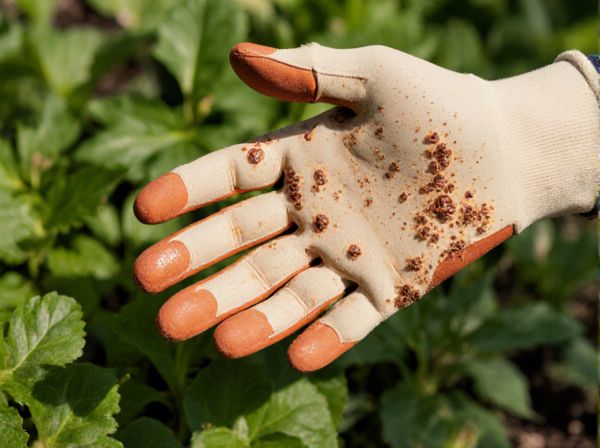
Anthracnose vs Botrytis Illustration
Anthracnose causes dark, sunken lesions primarily on leaves, stems, and fruit, leading to tissue death and yield loss, especially in warm, humid conditions. Botrytis, known as gray mold, primarily affects flowers, buds, and fruit by producing fuzzy gray spores that result in soft rot under moist environments. Both diseases reduce crop quality but target different plant parts and thrive in distinct environmental conditions, necessitating tailored management strategies.
Table of Comparison
| Disease | Pathogen | Symptoms | Host Plants | Environmental Conditions | Treatment | Prevention |
|---|---|---|---|---|---|---|
| Anthracnose | Fungal genus Colletotrichum | Dark, sunken necrotic lesions on leaves, stems, fruits | Tomato, mango, bean, avocado, citrus | Warm, humid conditions favor fungal growth | Fungicides such as chlorothalonil, copper-based sprays | Use resistant varieties, crop rotation, proper sanitation |
| Botrytis | Fungus Botrytis cinerea | Gray mold on flowers, leaves, fruit; soft rot | Strawberry, grape, lettuce, tomato, ornamental plants | Cool, moist conditions promote infection | Fungicides like fenhexamid, boscalid, cultural controls | Good air circulation, remove infected debris, avoid overhead irrigation |
Understanding Anthracnose and Botrytis
Anthracnose, caused by Colletotrichum species, primarily affects fruits, leaves, and stems, leading to dark, sunken lesions that can severely damage crops. Botrytis, commonly known as gray mold and caused by Botrytis cinerea, thrives in humid conditions and causes fuzzy gray spores on plant surfaces, often resulting in rot and significant pre- and post-harvest losses. Understanding the distinct fungal pathogens, their lifecycle, and environmental preferences is crucial for effective disease management and minimizing agricultural impact.
Key Differences Between Anthracnose and Botrytis
Anthracnose primarily causes sunken, dark lesions on fruits, leaves, and stems due to the fungal pathogens Colletotrichum species, whereas Botrytis, caused by Botrytis cinerea, leads to gray mold characterized by fuzzy gray spores on plant surfaces. Anthracnose often results in dry, leathery spots that may cause premature fruit drop, while Botrytis induces soft, watery rot, especially under humid conditions. Control measures differ as anthracnose responds well to copper-based fungicides and crop rotation, whereas Botrytis management emphasizes reducing humidity and using fungicides targeting gray mold fungi.
Causes and Triggers of Anthracnose
Anthracnose is primarily caused by fungal pathogens from the Colletotrichum genus, which thrive in warm, humid environments that promote spore germination and infection on plant tissues. Factors like prolonged leaf wetness, frequent rainfall, and high humidity serve as major triggers for anthracnose outbreaks in crops such as beans, tomatoes, and fruit trees. In contrast, Botrytis cinerea causes Botrytis blight, favoring cool, moist conditions and often infecting weakened or senescent plant tissues.
Causes and Triggers of Botrytis
Botrytis, commonly known as gray mold, is primarily caused by the fungus Botrytis cinerea, which thrives in cool, damp environments and infects a wide range of plants. The disease is triggered by excessive moisture, poor air circulation, and plant stress factors such as wounds or weakened immunity. Unlike anthracnose, which is caused by Colletotrichum species, Botrytis spreads rapidly under high humidity and low temperatures, making environmental conditions crucial for its development and severity.
Symptoms of Anthracnose in Plants
Anthracnose in plants is characterized by dark, sunken lesions on leaves, stems, and fruits, often with a distinct brown or black coloration. Infected areas may exhibit irregularly shaped spots that can merge, causing extensive tissue damage and defoliation. Early symptoms also include leaf curling and wilting, which impair photosynthesis and plant growth.
Symptoms of Botrytis in Plants
Botrytis, commonly known as gray mold, causes symptoms such as soft, water-soaked lesions on leaves, stems, and flowers, often covered with a fuzzy gray spore mass. Infected plant tissues frequently exhibit browning, wilting, and dieback, with rapid spread in humid conditions. The disease can lead to significant crop losses by affecting fruits, causing rot and premature decay during storage and transportation.
Best Practices for Preventing Anthracnose
Anthracnose prevention requires strict sanitation practices, including removing infected plant debris and pruning to enhance air circulation, reducing the moisture that favors fungal growth. Using resistant plant varieties and applying appropriate fungicides at early disease stages significantly lowers infection risks. Implementing crop rotation and ensuring proper irrigation techniques that avoid overhead watering further help minimize anthracnose outbreaks.
Effective Strategies for Controlling Botrytis
Effective strategies for controlling Botrytis cinerea include maintaining proper air circulation and reducing humidity levels in crop environments to limit fungal growth. Application of fungicides such as fenhexamid, boscalid, and cyprodinil during critical infection periods significantly reduces Botrytis outbreaks. Implementing sanitation measures like removing infected plant debris and employing resistant cultivars enhances long-term disease management.
Integrated Disease Management for Anthracnose vs Botrytis
Integrated Disease Management for Anthracnose involves cultural practices such as crop rotation, removal of infected debris, and use of resistant cultivars to reduce initial inoculum. Chemical control is optimized by applying fungicides with different modes of action during critical infection periods. For Botrytis, management emphasizes canopy ventilation, appropriate irrigation to reduce humidity, and timely fungicide applications targeting the gray mold fungus to effectively suppress disease development.
Choosing Resistant Plant Varieties for Disease Prevention
Selecting resistant plant varieties is crucial in preventing diseases like anthracnose and botrytis, as these fungi cause significant crop losses in tomatoes, strawberries, and grapes. Cultivars bred for resistance to Colletotrichum species help reduce anthracnose incidence, while varieties with enhanced defense against Botrytis cinerea minimize gray mold infections. Integrating disease-resistant genetics with proper cultural practices significantly improves plant health and yield stability.
Anthracnose vs Botrytis Infographic

 gardendif.com
gardendif.com